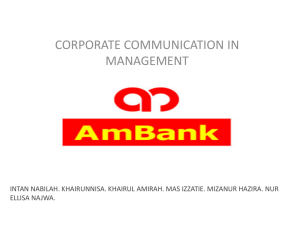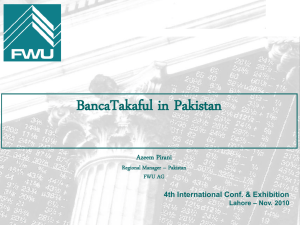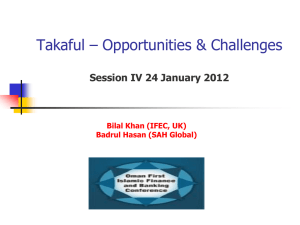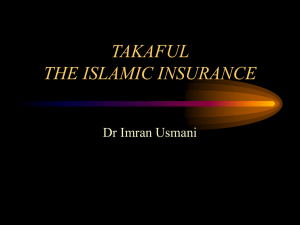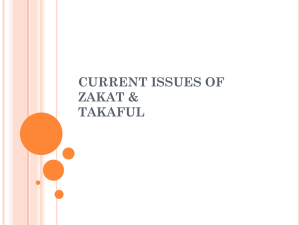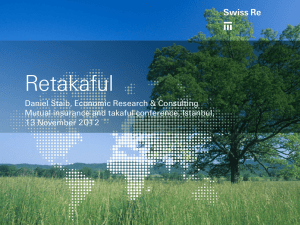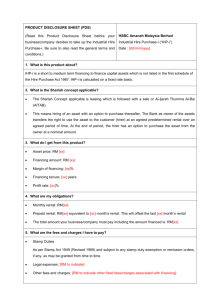Global takaful contributions grew by 31% in 2009, to US$7b
advertisement
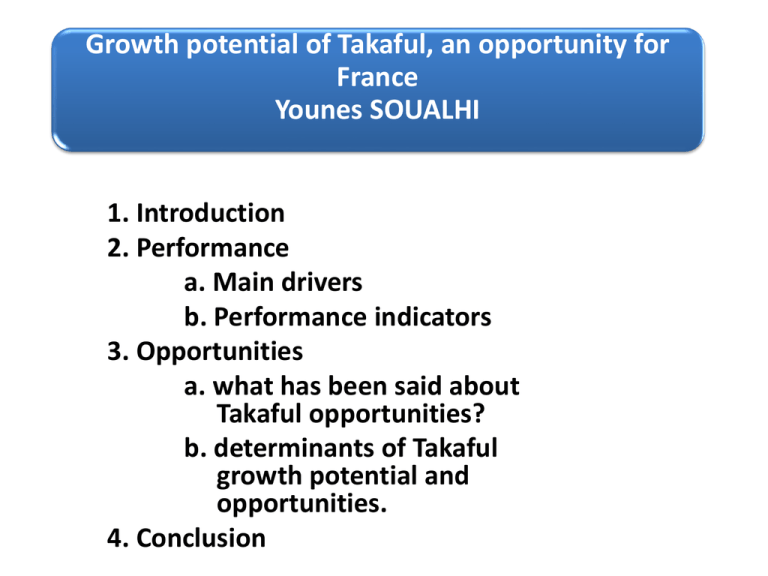
Growth potential of Takaful, an opportunity for
France
Younes SOUALHI
1. Introduction
2. Performance
a. Main drivers
b. Performance indicators
3. Opportunities
a. what has been said about
Takaful opportunities?
b. determinants of Takaful
growth potential and
opportunities.
4. Conclusion
Industry life cycle: Takaful is still hovering around ‘growth’ stage… innovation is
apparent to progress to the next phase…
MATURITY
GROWTH
SATURATION
INTRODUCTION
PRODUCTS*
SERVICES/
OPERATION*
Basic portfolio of
products
Product
development &
replication
Catch-up games
Basic services (Lagging
with
behind conventional
conventional
FIs)
FIs)
Diverse products
unique to the
Islamic sphere
Operates model that
is unique to takaful
Less products (eg.
product becomes
obsolete)
Old fashioned services
(eg. services does not
meet market
expectations)
… embracing Shariah principles coupled with a positive paradigm shift would
reinforce
product innovation to meet market’s demand
2
Global takaful contributions grew by
31% in 2009, to US$7b
.
Opportunities in core markets suggest
US$12b industry by 2011 (ERNST&Young 2011 )and
US15b by 2015 (Ajmal, HSBC Amanah)
Most GCC markets have witnessed a slowdown
in takaful growth, with only Saudi’s cooperative
insurance market remaining strong on the back
of compulsory medical.
(ERNST&Young 2011)
Global contribution growth
Growth 2011
12b
9.1b
SEA 29%
6.9b
GCC 31%
2009
2010
2011
ERNST&Young 2011
Main drivers
Products
surge
Healthy
competition
RoE
Improvement
in critical
mass levels
Steady
growth
Profitability
contributions
Surge
Capitalization
1. Surging Family Products
MRTT
Education
plan
Group
medical
Household
Takaful
Investment
linked
2. Healthy competition
(Etiqa and Takaful Malaysia)
Historical Performance
Takaful Malaysia Profit After Zakat Before Tax
(Company)
50,000
45,000
45,325
40,000
42,659
35,000
30,000
33,993
32,586
25,000
RM ('000)
20,000
15,000
14,361
10,000
5,000
0
2005
2006
2007
2008
2009
Historical Performance
Takaful Malaysia vs Etiqa Takaful
90,000
80,000
77,696
70,000
60,303
RM ‘000
60,000
58,314
50,000
Takaful Malaysia
Net Profit
40,000
37,182
30,000
31,041
28,024
23,172
20,000
15,818
10,000
0
2006
2007
2008
2009
Etiqa Takaful
Net Profit
Profitability Ratio
Earnings Per Share (EPS) sen
Year
Etiqa Takaful
Takaful Malaysia
2008
77.7
18.7
2009
58.3
24.2
Earnings per share represent the earning
generating ability of a company with regards to
the number of common stock (ownership shares)
outstanding.
Profit – Earning Ratio
Takaful Malaysia PE Ratio
This ratio shows how much investors are willing
to pay for every RM1 of earning that Takaful
Malaysia made. In this case, the ratio shows that
investors are only willing to pay RM0.056 for
every RM1 income made
Profitability Indicator
Wakalah Fees Charged
180,000
160,000
155,320
140,000
120,000
100,000
106,355
Etiqa
80,000
Takaful Malaysia
60,000
40,000
20,000
33,021
38,718
0
2008
2009
Liquidity Ratio
Takaful Malaysia
Company
Etiqa Takaful
Company
= 1.097
= 1.061
Firm’s strength in meeting short term
financial obligation. The bigger the better.
Operating Profit Margin
Takaful Malaysia
Company
Etiqa Takaful
Company
= 4.74%
= 4.45%
Operating profit margin evaluates a firm’s
effectiveness at controlling the costs and
expenses associated with their normal
business operation
Cost Efficiency
Management Expenses (RM'000)
142,189
148,420
81,235
68,199
2008
2009
Etiqa
Takaful
Total Takaful Funds (RM'000)
Year
Etiqa
Takaful
2008
4,953,301
1,855,134
2009
5,746,642
2,043,654
Management Expenses Ratio
Year
Etiqa
Takaful
2008
1.4%
7.7%
2009
1.4%
7.3%
Performance indicators
(ERNST&Young Report
2011)
Risk retention
Technical results
Underwriting leverage
Investment results
Operating efficiency
RoE (Net profit/shareholders equity) 2010
GCC: 10% (Tak)
11% (Ins)
Malaysia: 6% (Tak)
16% (Ins)
Average GCC
claims ratio:
54.05%
Malaysia
claims ratio:
33.7%
Retakaful ratio (retention)
GCC: 41% (Tak)
56% (Ins)
Malaysia : 7% (Tak)
21% (Ins)
GCC: 162% (Tak)
78% (Ins)
Malaysia: 268%
(tak)
221 %(Ins)
Yield on investment
GCC: 3.5%
Malaysia:
5.0%
Opportunities
What has been said about the
opportunities of takaful across the
world in General and France in
particular?
ERNST&Young 2011 report
• The industry is not without risks, but its
potential remains an important feature of
Muslim emerging markets for many
indigenous and global insurance players.
Oliver Wyman on the opportunities of Takaful in
Europe
Broad and exciting global growth opportunity,
offering a way to capture a huge and currently
underserved customer base inside the major
Western markets – and with profit streams that,
under a correctly designed model, could be
more stable than in conventional insurance.
(Oliver Wyman, 2)
• Western Europe, home to only 15 MM (or less
than 1%) of the world’s 1.6 billion Muslims,
makes up 40% of the potential ‘Muslim
demand’ today; adding the US brings the total
up to 60%
(Oliver Wyman, 2)
Alpen Capital on the opportunities of Takaful in general
1. Low penetration for Takaful products
2. Low Family Takaful penetration
2. Bancatakaful
3. Balance sheet restructuring
4. Consolidation
5. Cross border expansion
6. Solvency II
7. Takaful products for non-Muslims.
(Alpen Capital )
Hogan Lovells on the opportunities of
Takaful in the UK
• Established governance and regulatory
structures
• Favorable tax regime
• Flexible legal vehicle
• Pro-mutual stance of UK Coalition
Government
• The European market
(Hogan Lovelles)
Milliman on the opportunities of Tak.
• Favorable demographics – young, rapidly growing population
• Strong economic fundamentals and growth prospects of Islamic
countries
• Under-penetrated market
• Success of Islamic banking expected to boost Takaful
• Potential for Family Takaful in pluralistic societies
• Use of Family Takaful to promote economic activities
• Greater opportunity for growth than General Takaful
• Nil to low penetration
• Greater volume for wealth
• Greater impact on lives
()
(Afkar) on the additional opportunities of Takful
• Captive Structures
• Friendly Societies
• Discretionary Mutuals
Enass (France)
Ecole Nationale d’assurance
Les français déclarent rechercher :
• -la transparence
• -le partage des risques financiers
• -les informations
Et si le mode de finance islamique y répondait ?
• -un investissement de longue durée
• -le partage des risques et des profits
• -l’émergence du collectif au détriment de l’individuel
Rapport Jouini-Pastré (2008):
"la demande des produits takaful connaît une
croissance soutenue, alimentée par le
dynamisme économique, par la réduction de la
pauvreté et par une évolution démographique
favorable dans les pays concernés"
Opportunities
(determinants of the potentials of Takaful growth)
A. Main determinants:
1. Income level
2. Propensity to save
3. Inflationary outlook
4. Tax incentive
5. Demography
6. Employment
7. Cultural and religious tolerance to alternative
products.
B. Specific determinants:
1. Takaful potential vis.a vis GDP per Capita
France
World map showing countries above and below the world GDP (PPP) per capita, currently
$10,700. Source: IMF (International Monetary Fund).
Blue above world GDP (PPP) per capita
Orange below world GDP (PPP) per capita
Opportunities
( 2. Features)
Cooperation
Maqasid
based
Risk sharing
Features
Qard hasan
Profitability
Surplus
redistribution
Opportunities
(3. Market)
Sustainabl
e growth
(13%)
Demand
for ethical
finance
(Fr.)
Cross
border
expansion
(GCC)
Low
penetration
(many
untapped
markets)
Market
Increase of
saving and
protection
propensity as a
response to the
financial crisis
Investment
Rising
Stakeholders
confidence
NonMuslims
demand
Opportunities
(4. Economy)
Income level/
employment
Risk
profile
Inflation
Economy
Insurance
penetration
Insurance penetration:
(Gross premium/Nominal
GDP) in 2010.
France= 10.3 %
Total
premium
per GDP
(increasing
)
Total
premiums
per capita
(increasing
)
Opportunities
(5.legal/regulatory)
Tax incentives
Harmonizati
on between
shariah and
civil law
Legal/
Regulation/au
dit
&Governance
Alignment with
IFRS, Solvency II
and ICP
Robust legal
and shariah
frameworks
Opportunities
(6. products)
Wide
range
Products
for all
(M&nonM)
Cost
Products
Friendly
societies
(General and
Family&Medic)
Banca-
takaful
Mutuals
Captives
Malaysia: Comprehensive Takaful system
Diversified Players
Governance
• Banking:
Bankatakaful
•Brokers
•Agents
• Legal & Regulatory
– Takaful Act
– Takaful
operational
framework 2011
(New)
– Shariah
governance
framework 2011
(New)
• Shariah Advisory
Council
• Dispute Resolution
Professional Service
– Judicial system:
– Legal firms
–
dedicated high
–
Accounting
court
–
– Financial Intermediaries
–
– KL Regional
– Financial Advisors
Centre for
–
–
Consultancy
Service
Arbitration
–
– Financial
–
Mediation
Bureau of experiences in developing
30
44 years
Investment avenues
Shariah compliant equities
Funds
Islamic deposits
Government securities
Real estate, commodites
sukuk
takaful
Products
Family and General
Conclusion:
• Takaful has performed steadily but not without
troubles during the financial crisis that has
affected capital levels and asset values.
• The Takaful models chosen have affected
operating costs, leading many Takaful operators
to choose the “most profitable model”.
• balancing between business needs and
shariah&regulatory requirements will continue to
feature the Takaful industry for decades to come.
